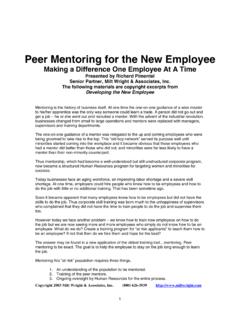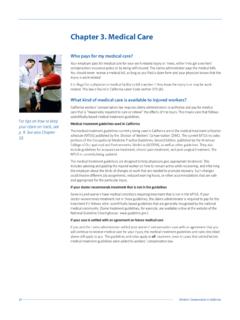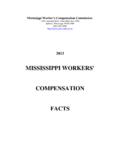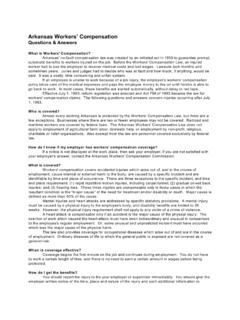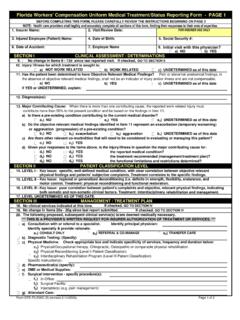Transcription of DISABILITY MANAGEMENT FOR NON-OCCUPATIONAL …
1 DISABILITY MANAGEMENT FOR. NON-OCCUPATIONAL injuries /ILLNESSES. By Rich Pimentel Milt Wright & Associates Inc Transitional Employment is traditionally designed to provide return-to-work opportunities for employees who become injured or ill on the job. At some point, each employer who implements a transitional employment program will be faced with the decision of whether to offer transitional employment to both occupationally and non-occupationally injured/ill employees. While the model works for both, there are significant issues that must be considered with any integrated occupational / NON-OCCUPATIONAL return-to-work process.
2 An employer can make the best decision for its needs and circumstances by comparing and contrasting the elements of occupational (Workers' Compensation) and NON-OCCUPATIONAL return to work. The following elements are examined in this section: 1. Employee Motivation 2. Medical Confidentiality and Access to Information 3. Employer Benefits 4. Work as Therapy 5. Transitional Employment Assignments -1- EMPLOYEE MOTIVATION. WORKERS' COMPENSATION NON-OCCUPATIONAL . The employee who is injured on the job is While the employee who becomes ill or often an ideal candidate for a DISABILITY injured off the job generally can benefit from MANAGEMENT Return-to-Work Program.
3 A DISABILITY MANAGEMENT Return-to-work Program, the motivation for the employee to Generally the injury is a result of some participate in the Program and the leverage trauma that does not allow the employee to the employer has to require him or her to return immediately to his or her regular cooperate is not clear-cut. Consider the duties. Overall, there are far more work- following issues: related injuries than illnesses. The nature of NON-OCCUPATIONAL problems The return-to-work process increases the is that there are far more illnesses than recovery and work morale of the employee.
4 injuries . Arthritis, diabetes, clinical The following elements are factors that depression, cancer, heart disease and increase employee motivation to actively high blood pressure are common non- participate: occupational illnesses. Often, in these cases, the inability to perform regular Transitional Employment serves as a bridge work duties is of secondary importance in the recovery process for the employee to to the need for treatment for occasionally transition to his or her regular duties. life threatening and long-term health considerations.
5 Because of this, any The employer is involved from day one and pressure from an employer for the the information supplied to the claims employee to return to work might be seen representative focuses on what activities the employee can and cannot do. as invasive and/or insensitive. Employee education is used to help the You may need to overcome the employee gain an understanding that employee's perspective that sick days . Transitional Employment helps both the and short or long-term DISABILITY are employee and the employer.
6 Generally seen more as an employee's right than time loss payments from The best DISABILITY MANAGEMENT Program Workers' Compensation. operates with the cooperation and support of the injured employee. FMLA supports the idea of not requiring an ill or injured employee to accept a Injured employees quickly fall into step modified or Transitional Employment with the logic that if there is work available that they could perform, the employer may assignment, the employer will need to require their cooperation in a return-to-work provide employee training on the effort.
7 Availability of Transitional Employment and the benefits of participating in a The Workers' Compensation system has built in DISABILITY MANAGEMENT Return-to-Work leverage to enforce cooperation by allowing Program. time loss benefits to be reduced or suspended for non-cooperation. COPYRIGHT MILT WRIGHT & ASSOCIATES 2003 1-800-626-3939. -2- MEDICAL CONFIDENTIALITY AND. ACCESS TO INFORMATION. WORKERS' COMPENSATION NON-OCCUPATIONAL . One of the realities of medical information In the case of NON-OCCUPATIONAL illnesses in Workers' Compensation is that because of and injuries , employers are much more the Workers' Compensation claim, restricted in their access to medical employers with an active DISABILITY information.
8 The new HIPPA regulations MANAGEMENT Return-to-Work Program have further limit the kinds of medical a need to know an injured employee's work information an employer might have related condition. This (or related) access to. information is vital to determining if the employee could benefit from a Transitional This restriction makes it more difficult to Employment assignment, and is crucial to determine which employees may or may Transitional Employment assignment not benefit from return to work. In design. addition, it can make early identification of return to work candidates problematic.
9 Access to medical information is vital to a Therefore, consider the following issues: timely DISABILITY MANAGEMENT Return-to- Work Program, and the Workers' Obtain a medical release form from Compensation system is designed to provide employees with a NON-OCCUPATIONAL the employer with this information as a medical condition who wish to return-to-work tool. For example: participate in a DISABILITY MANAGEMENT Return-to-Work Program. This will Changes in an employee's medical enable the employer to gather the condition are often updated weekly by information necessary to determine the physician, with the Transitional suitability of the Program, and as Employment Plan reflecting those appropriate the design of Transitional changes.
10 Employment assignments. If current information is not available or If the physician is slow to respond or there is a question about the employee's is non-cooperative in the DISABILITY condition that relates to return to work, MANAGEMENT return-to-work process, an appointment with the physician can the employer has few, if any, options be scheduled by the claims to expedite the process. Therefore it representative to obtain a quick answer. is important that any employee who requests Transitional Employment If medical information from a physician communicate with their physician that is delayed, a call from the DISABILITY this Program is something that he or manager can be arranged to expedite the she wants to do.

